Pilot 001 - Trace, Issue, Share, and View
Sponsor: RMI | Phase: 1 | Date: May 2025
The RBTP Knowledge Base is evolving weekly as part of our pilot programs with RBA members. We’d love your input — submit feedback or help shape the protocol in real time by joining a pilot.
1. Overview
Phase 1 of Pilot 001 demonstrated end-to-end, n-tier traceability using the RBTP Reference Implementation (RI). RMI participants followed digital credentials “from product to mine,” gaining hands-on experience tracing, issuing, sharing, and viewing supply-chain data.
Key Question:
How can I trace the materials in my manufactured part back through multiple tiers to the source mine and verify that RBTP supports n-tier traceability?
Answer:
- Interactive Value-Chain Map Modelled a segment of the chain with multiple upstream sources and hops.
- Guided Demonstration Walked users from an OEM’s Digital Product Passport—through Transformation Events and Digital Facility Records—to the originating mines.
2. Objectives
- Demonstrate core Reference Implementation functions via Interactive Value-Chain Map exercises—e.g. tracing product materials upstream to source mines
- Introduce the Reference Implementation tools through hands-on activities simulating real-world credential workflows—issuing, sharing, and viewing credentials
- Highlight business value by mapping product and facility claims (Digital Conformity Credentials) to Digital Facility Records and Digital Product Passports
3. Deliverables
Interactive Value Chain Map

Credential Catalog
| Credential Type | Examples |
|---|---|
| Facility Records (DFR) | - Core UNTP DFR: Mine, Smelter, Refiner - DEFR Extension: Digital Electronic Facility Record (OEM) |
| Product Passports (DPP) | - Core UNTP DPP: Copper Concentrate, Copper Cathode, Cobalt Concentrate, Refined Cobalt, Recycled Material - DPP Extension: Digital Battery Passport - DPP Extension: Digital Electronic Facility Record |
| Traceability Events (DTE) | - Transaction (Core UNTP – Sales) - Transform (Core UNTP – Smelting, Manufacture, Recycle) - Association (Core UNTP – Assembly) |
| Conformity Credentials (DCC) | - RMAP (Core UNTP – Responsible Minerals Assurance Process) - TSM (Core UNTP – Total Sustainable Mining) - RRA (Core UNTP - Risk Readiness Assessment performed by Coppermark) |
Published Exercises
| Step | Description |
|---|---|
| Trace | Follow the OEM’s Digital Product Passport back to the source mines |
| Issue | Publish a Digital Product Passport |
| Share | Share Product Passports with others |
4. Scope & Supply-Chain Actors
For this Phase 1 pilot, we defined a representative chain of seven actor types and generated synthetic credentials for each:
- Mine A (Copper; BCMines)
- Mine B (Lithium; Synthetic Facility)
- Smelter (Copper → cathode; BCMines)
- Refinery (Lithium + recycled; Synthetic Facility)
- Battery Manufacturer (Battery assembly; Synthetic Facility)
- OEM (Electronic-goods assembly; Synthetic Facility)
- Recycler (End-of-life goods → refinery feed; Synthetic Facility)
5. Phase 1 Pilot Process
| Step | Description |
|---|---|
| Scoping Discussion | Defined supply-chain segment and downstream disclosure requirements; confirmed “Trace, Issue, Share, and View” focus |
| SC Mapping Workshop | Refined supply-chain map; identified actors & credential types; populated map with synthetic data |
| Credential Development | Created synthetic Facility Records, Product Passports, Transformation Events, and Conformity Credentials |
| Demonstration and Published Exercises | Trace, Issue, Share, View Exercises published in the Reference Implementation Guides and Support section of the Knowledge Base. |
6. Next Steps
- Iterate & Refine: Incorporate feedback to enhance credential definitions and map granularity
- Phase 2 Planning: Identify candidate members for light-integration tests
- Tooling Enhancements: Leverage AI-driven workflows (e.g., CDS tool) for accelerated credential generation